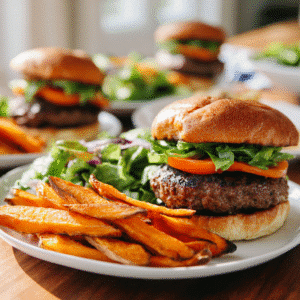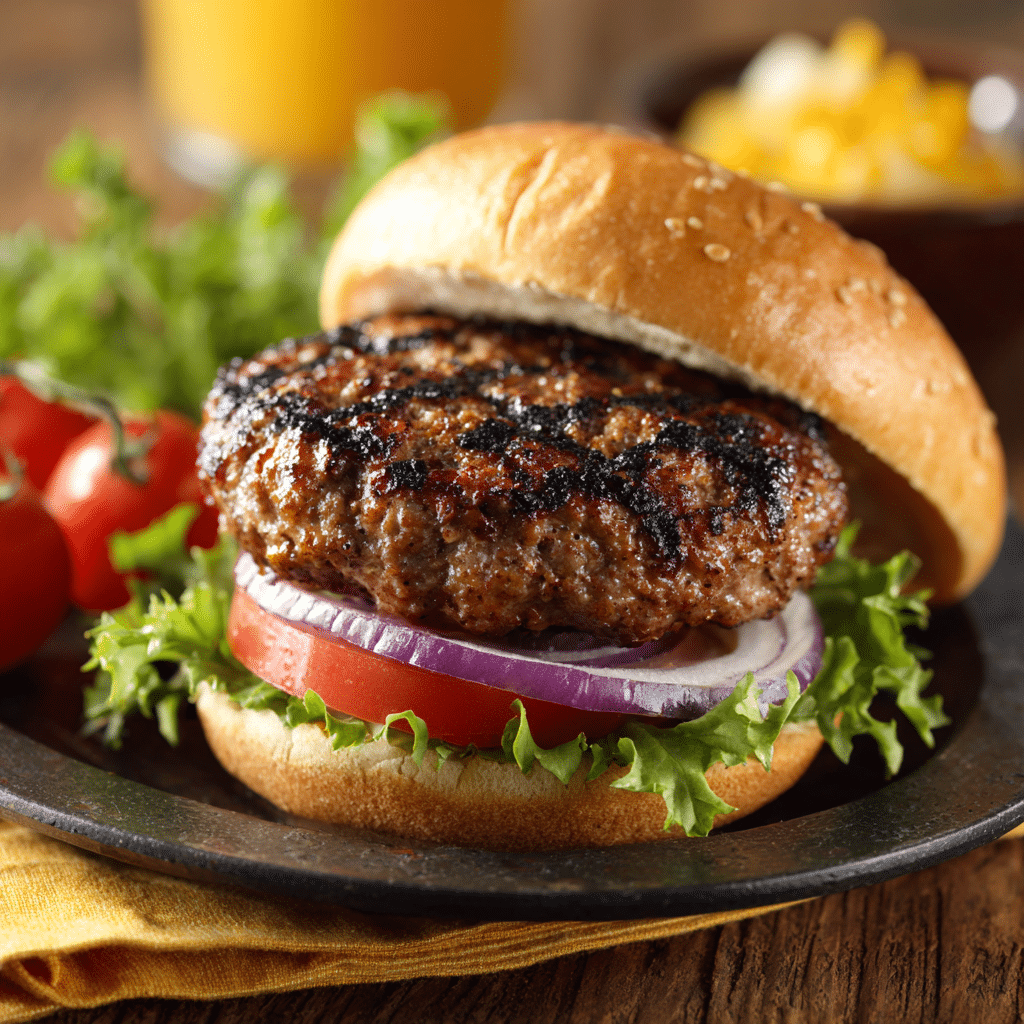
Bison burgers have become a favorite among health-conscious food lovers who want something more flavorful and nutrient-dense than traditional beef patties. Leaner, richer in protein, and packed with minerals, bison meat offers a unique twist on the classic burger experience. Unlike beef, it has a slightly sweeter flavor and a finer texture, making it ideal for those who enjoy a lighter but still satisfying meal. More restaurants and home cooks are discovering the benefits of bison, and it’s quickly gaining popularity as a premium choice for grilling season. Don’t miss our guide to healthy burger recipes for more inspiration on nutritious patties you can try at home.
Why Bison Burgers Changed the Way I Do Burger Night
How I Discovered the Secret to Better Burgers

A few summers ago, my husband Daniel came home from the local co-op with something unexpected: a package of ground bison. “It was on sale,” he shrugged. Skeptical but intrigued, I decided to give it a go. That night, we tossed a few bison burgers on the grill—and I was hooked. The meat was rich, almost sweet, with a depth that made regular beef taste flat by comparison. Ever since, bison burgers have been our go-to when we want something that feels special but still fits into a Tuesday night.
I started testing different seasoning blends and cooking methods, because while bison is tasty, it’s lean—and that means it dries out fast. After a few dry burgers and a couple that crumbled on the grill (more on that later), I cracked the code: simple seasoning, low-and-slow cooking, and just a touch of fat. It’s the kind of trick that makes bison burgers not just edible, but craveable.
Why Bison Works for Real-Life Meals
As a busy mom, I’m all about recipes that hit that sweet spot between practical and satisfying. Bison burgers are high in protein, low in fat, and easy to cook on a weeknight. They’ve even become part of our meal prep rotation—especially with easy sides like these gluten-free mac and cheese or a fresh bean salad with steak chimichurri.
Top them however you like—sautéed mushrooms, pepper jack, avocado—but no matter what, bison burgers bring bold flavor and real nourishment. For more ideas, check out my updates on Pinterest, Medium, or X, where I share what’s cooking in our real-life kitchen.
How to Season and Cook Bison Burgers for Flavor and Moisture
The Best Seasoning for Bison Burgers Starts Simple
When it comes to seasoning, I’ve found that bison burgers don’t need much to shine. Their natural flavor is earthy and slightly sweet—almost like beef, but more delicate. Over-seasoning can overwhelm it. Stick to kosher salt, cracked black pepper, and garlic powder as your base. For extra depth, I sometimes add smoked paprika or a pinch of onion powder. If I’m making them for guests, I’ll even stir in a splash of Worcestershire sauce or finely chopped shallots.
Fresh herbs like parsley or thyme can work too, but I save those for indoor stovetop versions where the flavor won’t get lost to the flame. Whatever combo you choose, be gentle—don’t knead or overmix the meat, or you’ll end up with tough burgers.
For those planning sides, these easy gluten-free dinner ideas work beautifully with the mild flavor of bison.
Keep Them Juicy: Low Heat, Quick Cook, Light Touch
Because bison is so lean, overcooking is your enemy. Always cook bison burgers over medium heat—not high. I prefer a cast iron skillet or a medium-hot grill. Form your patties about ¾-inch thick and make a small indentation in the center to prevent puffing.
Cook for about 4–5 minutes per side for medium-rare to medium. You’ll know they’re done when the outside is browned and the internal temp hits 140–145°F. Rest them for 3–4 minutes before serving to keep juices locked in.
To avoid crumbling (a common issue), chill the patties for 15–20 minutes before cooking. That helps them hold their shape on the grill. I also share tips like these in my family-friendly gluten-free meals, which offer flavor without fuss.
Once you master the basics, bison burgers become one of the easiest, most satisfying proteins you can cook.
Why Bison Burgers Cost More—And Why They’re Worth It
Understanding the Price Tag on Bison Meat
If you’ve ever blinked at the price per pound, you’re not alone. Yes, bison burgers cost more than beef—but once I learned why, it started to make sense. Bison are pasture-raised, not mass-produced. They aren’t treated with hormones or antibiotics, and they need more land to roam. That means higher quality meat—but also less of it available, which drives up the price.
Still, you can shop smart. I usually buy ground bison in bulk from local co-ops or online meat markets, then freeze what I don’t use. Some stores even run seasonal promotions, which is when I stock up. Compared to dining out or ordering gourmet burgers, cooking bison burgers at home still saves money—and you control every ingredient.
If you’re planning a cookout or family dinner, try pairing them with my easy gluten-free sides for a complete meal that feels restaurant-worthy without the bill.
The Health Perks of Choosing Bison Over Beef
Here’s the nutritional kicker: bison is leaner than beef, with fewer calories and less saturated fat. It’s packed with iron, B vitamins, and protein—without the heavy feeling beef can sometimes leave. That makes bison burgers a smart choice if you’re looking to cut back on red meat without giving up that juicy, meaty flavor.
For people with dietary restrictions, bison is naturally gluten-free and often easier to digest. I’ve found it to be a perfect protein for weeknight meals when I want something nourishing but light. If you’re trying to eat cleaner without sacrificing taste, bison gives you that flexibility.
Want a full-flavored but healthy follow-up? These vegetarian and gluten-free recipes round out your week without fuss. And for protein-packed breakfasts, don’t miss my master granola bar recipe.
With all that going for it, it’s no surprise bison burgers are gaining popularity—even if the price is a bit steeper.
Why Bison Burgers Fall Apart and How to Fix It
The #1 Mistake: Treating Bison Like Beef

The biggest mistake I see home cooks make with bison burgers is assuming they’ll behave like beef. They don’t. Beef has more fat to bind everything together—bison is lean, which means less moisture and less grip. If you skip the binder, over-handle the meat, or throw cold patties straight onto high heat, don’t be surprised if they crumble.
Here’s what works: Start by gently mixing your ground bison with a binder. One beaten egg and a tablespoon of gluten-free breadcrumbs (or even almond flour) per pound of meat does the trick. You don’t need much—just enough to keep the burger from drying and cracking.
For extra insurance, chill the patties in the fridge for 20–30 minutes before cooking. That helps them firm up. I mention this trick often in my meal-prep friendly recipes because it’s such a simple win.
Form, Cook, and Flip with Intention

When forming bison burgers, don’t pack them like snowballs. Use light hands and keep them just thick enough to cook through without drying. A slight thumbprint in the center helps them stay flat while cooking.
Cook over medium—not high—heat. Flip only once, and don’t press them down with your spatula (you’ll squeeze the juices out). Let them rest for at least three minutes after cooking so they stay juicy inside.
Once you get the hang of it, bison burgers are just as easy as beef—maybe even easier, once you taste the results. Pair them with something light and flavorful like this paleo mango coconut bar for a sweet-and-savory finish.
For more gluten-free success stories and practical kitchen advice, follow along on Tumblr where I break it down step-by-step.

FAQs
Is bison meat good for burgers?
Yes—bison burgers are not only good, they’re excellent. Bison has a naturally rich, slightly sweet flavor that stands out from traditional beef. It’s also leaner and packed with nutrients like iron and B vitamins. Just be sure not to overcook it—it’s lower in fat, so it needs a little more care during cooking to stay juicy.
What is the best seasoning for bison burgers?
Keep it simple: salt, black pepper, and garlic powder are often all you need. Additions like smoked paprika, Worcestershire sauce, or finely chopped shallots can take things up a notch without overwhelming the meat’s natural taste.
Why is bison meat so expensive?
Bison burgers tend to cost more because bison are pasture-raised, not factory-farmed. They require more space and time to mature, and they aren’t treated with growth hormones or antibiotics. That makes the meat cleaner and higher quality—but also more limited, which affects price.
Why do bison burgers fall apart?
They’re lean, which means less fat to hold them together. Skipping binders, overmixing, or not chilling the patties before cooking can cause them to crumble. Adding a binder like egg and breadcrumbs and chilling before grilling makes a huge difference.
Conclusion:
If you’ve been sticking to beef out of habit, bison burgers might just be your next favorite discovery. They’re flavorful, protein-rich, and surprisingly easy to master with the right tips. From seasoning smartly to cooking gently and forming patties that hold together, everything you need for a successful bison night is doable—even on a busy weekday.
Whether you’re looking for cleaner meals, trying something new, or just want to impress at your next cookout, bison delivers. You can pair them with Mediterranean gnocchi, gluten-free banana pudding, or keep it classic with a quick side salad.
For more flavor-packed ideas tested in a real kitchen (mine!), follow along on X, Pinterest, and Tumblr. Let’s make dinner something you actually look forward to.
Table of Contents

Bison Burgers
Equipment
- mixing bowl
- grill or cast iron skillet
- spatula
- thermometer (optional for doneness)
Ingredients
- 1 lb ground bison
- 1 egg (optional, for binding)
- 1 tbsp gluten-free breadcrumbs or almond flour
- 1 tsp kosher salt
- 1/2 tsp cracked black pepper
- 1/2 tsp garlic powder
- 1/4 tsp smoked paprika (optional)
- 1 tsp Worcestershire sauce or minced shallots (optional)
- oil for greasing skillet or grill
- toppings: avocado, cheese, sautéed mushrooms, etc.
- gluten-free burger buns or lettuce wraps
Instructions
- In a large bowl, gently mix ground bison with salt, pepper, garlic powder, and optional egg, binder, and other seasoning.
- Form into 4 patties, about ¾-inch thick. Press a slight dimple in the center of each to prevent puffing. Chill in the fridge for 20 minutes.
- Preheat a cast iron skillet or grill over medium heat. Lightly oil the surface to prevent sticking.
- Cook patties for 4–5 minutes per side, or until internal temp reaches 140–145°F for medium. Flip only once; don’t press down on patties.
- Remove burgers from heat and let rest 3–4 minutes before serving. Assemble with your favorite toppings and enjoy.

